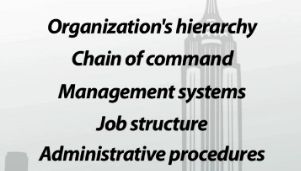Types of Internal Organizational Change: Structural, Strategic, People, and Process
After you watch the video and know the material, click HERE for the quiz.
Organizational change can occur in response to internal or external factors. This lesson focuses specifically on those changes that occur in a company's internal environment, including structural, strategic, people and process changes.
Change in Organizations
Most organizations have to change as part of keeping up with the competition or adjusting to new market trends or technologies. Things such as mergers, restructuring, technological advancements, process enhancements, changing customer demands and new product lines are fairly common in today's business environments. If you recall, reasons for change can be attributed to an organization's external environment as well as their internal environment. This lesson will focus specifically on those changes that occur in a company's internal environment, including structural, strategic, people and process changes.
 |
Structural Change
Structural changes are those changes made to the organization's structure that might stem from internal or external factors and typically affect how the company is run. Structural changes include things such as the organization's hierarchy, chain of command, management systems, job structure and administrative procedures. Circumstances that usually create the need for structural change include mergers and acquisitions, job duplication, changes in the market and process or policy changes.
 |
Strategic Change
Strategic change involves making changes to the overall goals, purpose, strategy or mission of an organization. It is a major upheaval to how the organization conducts business. The external environment of an organization can, at times, place significant demands on an organization that it must rethink its fundamental approach to business. Changes to things such as what products or services it offers, the target customer segments or markets it tries to reach, how the company distributes its products or services, its position in the global economy and who it will partner with for manufacturers, distributors and other logistical needs are just some examples of strategic changes.
 |
People Changes
People changes are directed towards improving employee performance, skills, attitudes, behavior and loyalty to the organization, as well as to enhance manager-subordinate relationships, group cohesion and employee sense of achievement. Changes to people can be large-scale, such as replacing all of the top-level managers in hopes of creating a new organizational culture, or small-scale, such as working to change employee attitudes though things such as team building or other behavioral activities.
 |
Process Change
Process changes are used to improve the overall workflow efficiency and productivity within an organization. Process changes affect an organization's production operations, such as how it produces its products, how it delivers its services or how it handles everyday business practices. Switching from paper bills to electronic ones as part of changing to a web-based service is an example of a process change that Catelyn and Cory would implement at their communications firm.
 |
Lesson Summary
Let's review. Reasons for change can be attributed to an organization's external environment as well as their internal environment. This lesson focused specifically on those changes that occur in a company's internal environment, including structural, strategic, people and process changes. Structural changes are those changes made to the organization's structure that might stem from internal or external factors and typically affect how the company is run. Strategic change involves making changes to the overall goals, purpose, strategy or mission of an organization. People changes are directed towards improving employee performance, skills, attitudes, behavior and loyalty to the organization, as well as to enhance manager-subordinate relationships, group cohesion and employee sense of achievement. Process changes are used to improve overall workflow efficiency and productivity within an organization.